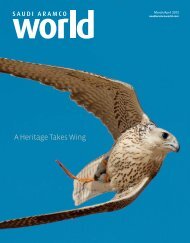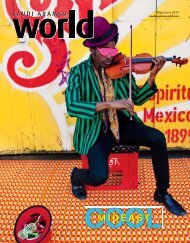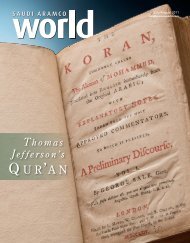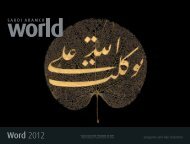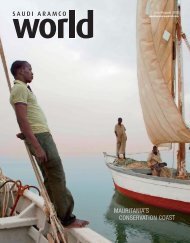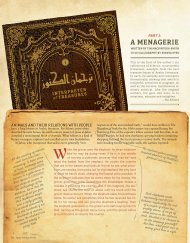ArabicintheSky - Saudi Aramco World
ArabicintheSky - Saudi Aramco World
ArabicintheSky - Saudi Aramco World
Create successful ePaper yourself
Turn your PDF publications into a flip-book with our unique Google optimized e-Paper software.
the cultural heritage of ancient Afghanistan<br />
from the Bronze Age (2500 BCE)<br />
through the rise of trade along the Silk<br />
Roads in the first century CE. Among<br />
the nearly 230 works on view, all from<br />
the National Museum of Afghanistan<br />
in Kabul, are artifacts as old as 4000<br />
years, as well as gold objects from the<br />
famed Bactrian Hoard, a 2000-year-old<br />
treasure of Bactrian grave goods excavated<br />
at Tillya Tepe in 1978. The earliest<br />
objects in the exhibition, from Tepe<br />
Fullol in northern Afghanistan, are fragmentary<br />
gold vases dated between<br />
2500 and 2200 BCE. A second group,<br />
from the former Greek city Aï Khanum,<br />
reflects Mediterranean influence<br />
between the fourth and second centuries<br />
BCE. Trade goods from a third site,<br />
at Begram, date from the first century<br />
CE and include ivory statues and reliefs<br />
and goods imported from Roman,<br />
Indian, Chinese and East Asian markets.<br />
The Tillya Tepe group of first-century<br />
gold objects includes an exquisite<br />
crown and necklaces, belts, rings and<br />
headdresses. Kunst- und Ausstellungshalle,<br />
Bonn, through October 3; British<br />
Museum, London, Spring 2011.<br />
Hussein Chalayan: 1994–2010 provides<br />
insight into the uniquely interdisciplinary<br />
approach that has made<br />
UK-based British/Turkish-Cypriot fashion<br />
designer Hussein Chalayan worldrenowned,<br />
presenting fashion collections,<br />
films and installations from 1994<br />
through 2009. Istanbul Museum of<br />
Modern Art, through October 10.<br />
A Gift from the Desert: The Art,<br />
History and Culture of the Arabian<br />
Horse explores the impact of the<br />
horse on civilizations of the ancient<br />
Near East and the Islamic world, and<br />
highlights the beauty and romance<br />
of the Arabian breed. Arabian horses<br />
relate to many aspects of the arts<br />
and cultures of the civilizations<br />
that treasured them, as well as the<br />
important role of the ancient Near<br />
East, Egypt and Arabia in equestrian<br />
history. The nearly 400 objects on<br />
display, from 27 museums and private<br />
lenders, include a petroglyph (rock<br />
carving); a Sabean stela showing<br />
camels and riders; illuminated copies<br />
of the Qur’an; a Mamluk gilded glass<br />
pilgrim flask; a 2000-year-old golden<br />
bridle found in the UAE; second-century<br />
frescoes from the “lost city” of Fao in<br />
<strong>Saudi</strong> Arabia’s Empty Quarter; objects<br />
related to Islamic mathematics,<br />
astronomy and navigation; glass,<br />
ceramic and metalwork from the early<br />
Islamic dynasties through the Ottoman<br />
Empire; art and lithographs depicting<br />
horses; and Islamic arms and armor.<br />
International Museum of the Horse,<br />
Lexington, Kentucky, through<br />
October 15.<br />
Tarjama/Translation: Contemporary<br />
Art From the Middle East and its Diasporas<br />
features the works of Khaled<br />
Hafez, Akram Zaatari, Lara Baladi,<br />
Wael Shawky, Farhad Moshiri, Khalil<br />
Rabah and Khaled Ramadan, among<br />
others, as they explore cultural and<br />
artistic translations from the interpretation<br />
of history to the relationship<br />
between languages, images and texts.<br />
Johnson Museum of Art, Ithaca, New<br />
York, through October 17.<br />
Three Takes on Dress. Dress is about<br />
what people wear to say who they<br />
are, what they are doing and why. The<br />
exhibition presents three totally different<br />
snapshots of dress from India, Jordan<br />
and Turkey. It features a Bedouin<br />
dress from Jordan that is three meters<br />
long and nearly 2.5 meters wide,<br />
sleeve end to sleeve end; fine 19thand<br />
20th-century examples of badla<br />
metal-thread embroidery from India,<br />
Iran and Egypt; and, from Turkey, a late<br />
19th-century circumcision outfit worn<br />
on this milestone event in a boy’s life.<br />
TRC Gallery, Leiden, Netherlands,<br />
through October 20.<br />
Arabia, an IMAX 3-D film shot at more<br />
than 20 locations across <strong>Saudi</strong> Arabia,<br />
provides a vivid portrait of the history,<br />
culture and religion of the Arabian Peninsula.<br />
The movie mixes scenes of<br />
modern-day life in the kingdom with<br />
images of its natural and built heritage,<br />
and looks into the future through the<br />
eyes of young <strong>Saudi</strong>s. Actress Helen<br />
Mirren narrates, but the film’s real<br />
voice is Hamzah Jamjoon, a Jiddawi<br />
film student at Chicago’s DePaul University.<br />
He sets out with a film crew to<br />
explore his Arabian identity, diving in<br />
the Red Sea, flying over dune and<br />
oasis towns, riding camels with the<br />
Bedouin and exploring Madain Salih,<br />
the 2000-year-old Nabataean town<br />
famous for its huge sandstone tombs.<br />
Viewers also join three million Muslims<br />
making the pilgrimage to Makkah<br />
with another <strong>Saudi</strong>, Ni‘mah Ismail<br />
Nawwab. A photographic companion<br />
book, Arabia: In Search of the Golden<br />
Ages, is available. Science Museum of<br />
[St. Paul] Minnesota, through October<br />
24; Texas State History Museum,<br />
Austin and Science Spectrum,<br />
Lubbock, Texas, through October 30;<br />
Museum of Science, Boston, Science<br />
Center of [Des Moines] Iowa, Louisville<br />
[Missouri] Science Museum and<br />
Papalote Museo del Niño, Mexico<br />
City, through December 30; Auto &<br />
Technik Museum, Sinsheim, Germany,<br />
through January; Museum of<br />
Discovery and Science, Ft. Lauderdale,<br />
Florida, through January 30,<br />
2011; Marbles Kids Museum, Raleigh,<br />
North Carolina, through February 28,<br />
2011; Scientific Center, Salmiya,<br />
Kuwait, through July 23, 2011.<br />
The Turks in Vienna: The History<br />
of a Jewish Community. In Spain,<br />
the fateful year 1492 saw the end of<br />
800 years of Muslim rule, the departure<br />
of Columbus for the New <strong>World</strong><br />
and the expulsion of the Jews. The<br />
latter found refuge, above all, in the<br />
Ottoman Empire, and after the Ottoman–Habsburg<br />
peace treaties in the<br />
first half of the 18th century, Sephardic<br />
Jews established a community<br />
in Vienna. They linked East and<br />
West, Asia and Europe, not only as<br />
merchants and dealers importing wool<br />
and cotton, silk and tobacco, sugar<br />
and spices to the West, but also culturally,<br />
setting up the first print shop<br />
in Constantinople and making Arab<br />
philosophy and medicine available to<br />
the western world. Jewish Museum<br />
Vienna, through October 31.<br />
Current November<br />
Mysterious Tomb 63: The Latest<br />
Discovery in the Valley of the Kings:<br />
Art and Archaeology of Susan Osgood<br />
displays 100 works on paper with<br />
objects from museum collections, linking<br />
the artist’s two worlds. The archeological<br />
works include drawings and<br />
photographs of the coffins in KV 63,<br />
the first new tomb to be discovered<br />
in the Valley of the Kings since 1922,<br />
and drawings of Medinet Habu’s Small<br />
Temple and of a Thutmosis III sculpture<br />
fragment. The contemporary art<br />
includes travel sketchbooks and four<br />
series of paintings and prints inspired<br />
by Osgood’s 30 years working and<br />
traveling in Egypt. Kestner Museum,<br />
Hannover, Germany, through<br />
November 7.<br />
Mummified allows visitors at computer<br />
stations to experience the “virtual<br />
autopsy” of the museum’s<br />
mummy, undertaken to learn more<br />
about the age, possible illness and<br />
cause of death of the person within<br />
the beautifully painted outer wrappings.<br />
The exhibition also features<br />
some 20 ancient Egyptian objects<br />
depicting images of mummified people,<br />
animals and deities, and discusses<br />
the “mummimania” of the 17th to<br />
20th centuries. Walters Art Museum,<br />
Baltimore, through November 8.<br />
Philip Taaffe, Christine Streuli, Timo<br />
Nasseri explore patterns, colors and<br />
geometries in a group exhibition.<br />
American artist Philip Taaffe’s works<br />
on paper examine the artistic technique<br />
of repetition and change; Swiss<br />
artist Christine Streuli’s intricate canvases<br />
draw on the history of rhythmic<br />
patterns in textiles; German-Iranian artist<br />
Timo Nasseri’s detailed drawings<br />
and sculptures evoke ancient Persian<br />
mathematics and their relationship<br />
to mystical design and architecture.<br />
Sfeir-Semler Gallery, Beirut, Lebanon,<br />
through November 13.<br />
Current December<br />
The Qur’an in its 1400th Year displays<br />
for the first time a selection of<br />
50 calligraphic copies and partial copies<br />
of the Qur’an from the museum’s<br />
250,000-page “Damascus Documents”<br />
collection, including the<br />
oldest known copies of parts of the<br />
holy book, dating from the year 875,<br />
and others written on antelope hide.<br />
The collection was brought to Istanbul<br />
when the Umayyad Mosque in<br />
Damascus burned down at the end<br />
of the 19th century. Museum of Turkish<br />
and Islamic Art, Istanbul, through<br />
December 1.<br />
Desert Jewels: North African Jewelry<br />
and Photography from the Xavier<br />
Guerrand-Hermès Collection combines<br />
previously unexhibited North African<br />
jewelry and late 19th- and early 20thcentury<br />
photographs. Jewelry designers<br />
and -makers used silver, coral,<br />
amber, coins and semiprecious stones<br />
to create wedding necklaces, hair<br />
ornaments, bracelets, rings, earrings<br />
and fibulae, which show the common<br />
elements of North African societies as<br />
well as local variations in materials and<br />
motifs. North African jewelry came<br />
to the attention of western collectors<br />
only in the 19th century, and important<br />
photographers of the day visited the<br />
region and photographed landscapes,<br />
architecture, markets and people<br />
adorned in their jewels. Philadelphia<br />
Museum of Art, through December 5.<br />
Weavers’ Stories From Island<br />
Southeast Asia lets weavers and<br />
batik artists speak for themselves<br />
in videos recorded at eight sites in<br />
Indonesia, Malaysia, the Philippines<br />
and East Timor. A panoply of human<br />
emotions and experiences—determination,<br />
longing, dream inspiration,<br />
theft, war and more—emerges<br />
from the stories of these remarkable<br />
women. The videos are accompanied<br />
by textiles created by each of the featured<br />
artisans. Fowler Museum at UCLA,<br />
Los Angeles, through December 5.<br />
Nini Towok’s Spinning Wheel: Cloth<br />
and the Cycle of Life in Kerek, Java<br />
explores the multiple meanings of the<br />
beautiful rustic textiles from Kerek,<br />
the last place in Java where batik is<br />
still produced on handwoven cotton<br />
cloth and where a full range of handwoven<br />
textiles still supports a remarkable<br />
system of interrelated beliefs and<br />
practices. Nini Towok is the Javanese<br />
goddess who cultivates cotton in the<br />
heavens and sends her yarn to Earth in<br />
the form of moonbeams. Fine examples<br />
of these rarely seen cloths illustrate<br />
the various techniques, patterns<br />
and color combinations, and the exhibition<br />
concludes with a series of 17 outfits,<br />
each specific to a particular individual<br />
according to sex, age, social<br />
status, occupation and place of residence.<br />
Fowler Museum at UCLA, Los<br />
Angeles, through December 5.<br />
Traces of the Calligrapher: Islamic<br />
Calligraphy in Practice, c. 1600–1900<br />
and Writing the Word of God: Calligraphy<br />
and the Qur'an celebrate the rich<br />
religious and artistic tradition of calligraphy,<br />
or “beautiful writing,” the most<br />
esteemed of the Islamic visual arts.<br />
The works of calligraphy—from practice<br />
alphabets to elaborately finished<br />
manuscripts—serve as traces of individuals,<br />
belief systems and cultures,<br />
and the costly and exotic materials<br />
lavished on writing instruments document<br />
the international trade of the<br />
period, from 1600 to 1900, and create<br />
a rich material legacy that fuses<br />
esthetics and piety. Some 150 objects<br />
and works convey the elegance of<br />
the esteemed art form and reveal the<br />
skills of the many artisans—calligraphers,<br />
paper makers, gold beaters, illuminators,<br />
bookbinders and metalworkers,<br />
to name a few—involved in the<br />
creation of the tools, the calligraphies<br />
and the manuscript folios. Traces of<br />
the Calligrapher maps the practice of<br />
the calligrapher from the 17th through<br />
the 19th centuries through examples<br />
of calligraphy and through the tools of<br />
the trade. The objects in the exhibition<br />
come from Iran, Turkey and India<br />
and include reed pens, penknives and<br />
maktas (used to hold the pen while it<br />
is cut) in addition to inkwells, scissors,<br />
burnishers, storage boxes and writing<br />
tables. Writing the Word of God<br />
is devoted to key developments of<br />
the Islamic scripts of distinct cultural<br />
areas, spanning from Spain and North<br />
Africa to greater Iran and from the seventh<br />
to the 15th centuries. A selection<br />
of approximately 20 folios from nowdispersed<br />
copies of the Qur’an from<br />
various regions will illustrate the rich<br />
variety and system of scripts. Carlos<br />
Museum, Emory University, Atlanta,<br />
through December 5.<br />
Treasures of the <strong>World</strong>: Jewellery of<br />
India Under the Grand Moguls includes<br />
pieces that exemplify the artistic<br />
sophistication and technical finesse<br />
of Indian craftsmen in the age of the<br />
Mughals, especially during the 16th,<br />
17th and 18th centuries. The Indian<br />
Subcontinent, rich in gems, is home<br />
September/October 2010 47



